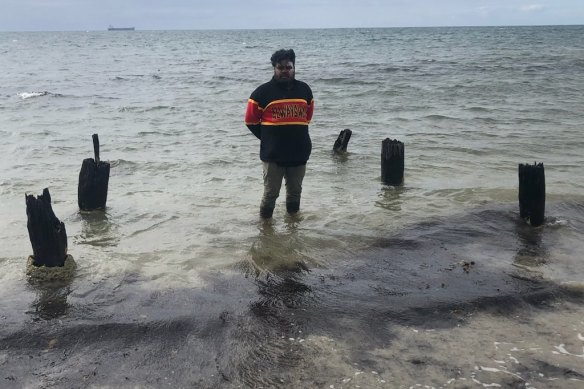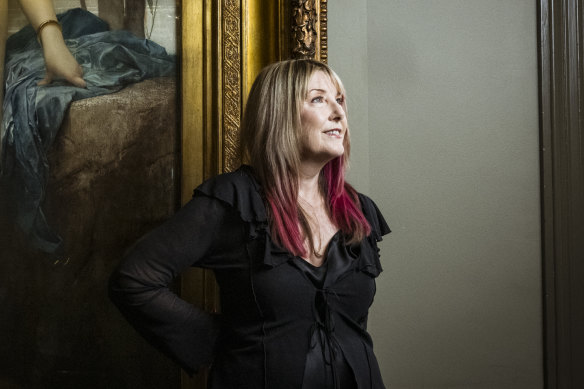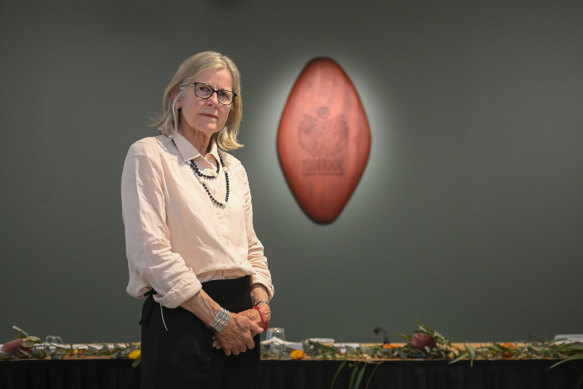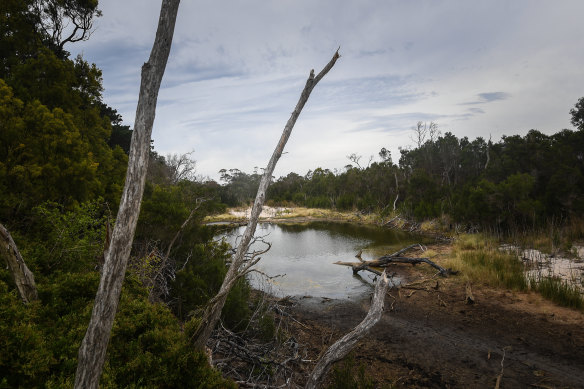This was published 9 months ago
My ancestor knew more about atrocities against Aboriginal people than he let on, inquiry told
By Tony Wright
An award-winning writer, Dr Katrina Kell, suspects her sea-captain ancestor, James Liddell, knew more than he ever revealed about atrocities against Victoria’s Aboriginal people, including the first known massacre, which occurred at a whaling station known as The Convincing Ground near Portland.
Liddell was the captain of the sailing ship Thistle, which brought to Victoria the reputed first permanent European settlers, the Henty family, who illegally took up land in the south-west in the 1830s.

Gunditjmara man Chris Saunders and the remnants of a whalers’ jetty at The Convincing Ground, where an unknown number of Aboriginal people were massacred in the early 1830s.Credit: Tony Wright
“My ancestor, Captain James Liddell, was employed by Edward Henty during a violent period of land theft and genocide in Gunditjmara Country,” Kell told the Yoorrook Justice Commission, Victoria’s truth-telling inquiry into injustices experienced by First Peoples in Victoria.
“Based on historical records, he appears to have happily done Henty’s bidding, which makes it hard to believe he was unaware of the atrocities.
“It is distressing to consider, as his descendant, that he may have perpetrated some of the violence.”
Kell is a research associate at Murdoch University, Western Australia, and author of Chloe, the story behind the model for the famous painting that has hung for a century at Young and Jackson’s Hotel on Flinders Street.

Dr Katrina Kell, pictured earlier in the year.Credit: Chris Hopkins
Kell is one of two non-Indigenous women who called for a greater acknowledgment of white atrocities against Aboriginal people in their submissions to the commission on Wednesday.
Both women called for the Australian War Memorial to grant formal recognition of the Frontier Wars between European settlers and First Peoples.
Elizabeth Balderstone, a grazier whose South Gippsland property includes the site of the Warrigal Creek Massacre of 1843, described how her family and neighbours had protected the site for years, and told of her ongoing efforts to return the area to the care of traditional owners.
“In July 1843, just over two years after European settlement began in Gippsland, a band of settlers known as the Highland Brigade shot between 60 and 150 Brataualung people in retribution for the murder of Ronald Macalister, the nephew of a wealthy pastoralist, Lachlan Macalister,” Balderstone said.

Elizabeth Balderstone’s family own the property on the site of the Warrigal Creek massacre.Credit: Justin McManus
She and neighbours had ensured the massacre site now sat undisturbed by farming activities.
“The area around the site has been fenced off for many years – by us on our side of the creek and by our neighbours on the northern side,” Balderstone said.
“So the site now sits quietly and undisturbed. Beautiful and abundant birdlife that inhabits the area is on constant watch, and on some level I connect with and acknowledge the site every day.”
Balderstone said she and her family had investigated ways to return the land to traditional owners, including a joint management agreement and cultural covenants.

The Warrigal Creek Massacre site in South Gippsland.Credit: Justin McManus
However, both of these methods had limitations and “I do worry how enforceable they might be with a difficult property owner [in the future]”.
Balderstone said she was continuing to explore a workable method, and declared herself “very supportive” of the idea of an annual or regular payment by primary producers and landholders, similar to council rates, to help traditional owners care for their Country.
Kell told the commission she was a fourth-generation matrilineal descendant of sea captain James Donaldson Liddell.
Liddell was captain of the Thistle, “which brought the Henty brothers to Gunditjmara Country, where they took up land illegally”, she said.
The Henty brothers – whalers and graziers generally considered Victoria’s first permanent European settlers – landed in Portland, south-west Victoria, in 1834.
The Hentys and other whites became so feared by Aboriginal people that the chief protector of Aborigines, George Augustus Robinson, wrote in 1841 that Henty had told him “the blacks” had not visited the Portland settlement for several years, and the elders of a clan at nearby Mount Clay “would not allow white people to come to them”.
Robinson remarked in his journal that he felt Aboriginal people were “wise” to keep their distance.
Kell said Liddell had earlier visited Portland with Thomas and Edward Henty and their whaleboats and crews in December 1833.
She found the timing significant because the massacre by whalers at a place called The Convincing Ground north of Portland, believed to have wiped out most of the Kilcarer Gunditj clan, is thought to have occurred between March 1833 and March 1834.
Liddell, who normally kept meticulous records, remained unusually vague about the visit, and wrote that he “forgot the reason” why he did not leave a whaleboat and crew in Portland when he and the Hentys departed. Kell found it curious and disturbing.
However, she said one of the most distressing discoveries about Liddell was his involvement in the abandonment of Kalloongoo, the young Aboriginal woman who William Dutton had “bought” from a Kangaroo Island whaler.
Dutton arrived in Portland before the Hentys in the 1820s. But according to the late Portland historian Joe Wiltshire, the Hentys were unimpressed to find Dutton living with a black woman, and arranged to have her shipped away – even though she and Dutton had a child, Sophie.
On January 5, 1835, Liddell sailed from Portland with a cargo that included in the manifest “Black Woman belonging to Wm Dutton to be landed at Kings Island”.
Sophie stayed with Dutton. Kalloongoo’s story continued to be one of unrelenting misery.
Later still, Liddell and Dutton disagreed in sworn declarations published in The Hamilton Spectator about whether Dutton or the Hentys were Victoria’s “first colonists”.
Kell told the commission: “As a descendent of James Liddell, I feel ashamed and find it appalling that the Gunditjmara people, the rightful owners of Portland Bay and surrounds, people who have occupied and farmed these lands for at least 30,000 years, were not mentioned or acknowledged in either Liddell or Dutton’s sworn declarations.”
Start the day with a summary of the day’s most important and interesting stories, analysis and insights. Sign up for our Morning Edition newsletter.